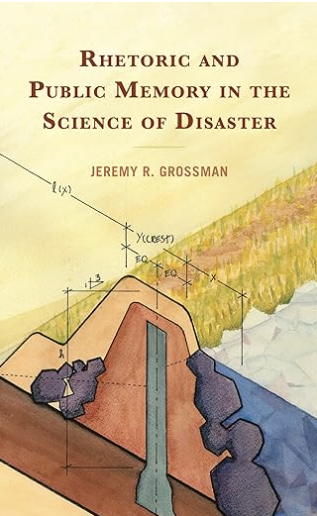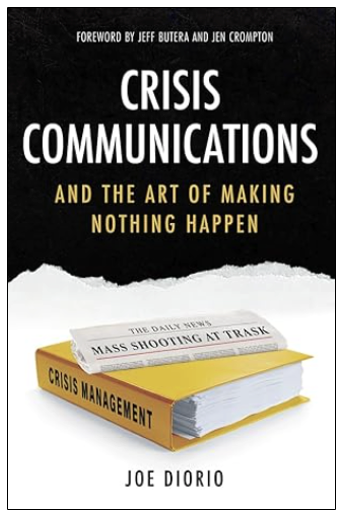Crisis Communication Book Reviews

Rhetoric and Public Memory in the Science of Disaster
Jeremy R. Grossman. Lanham, MD: Lexington Books. 2024. 174 pages, including index
Index Terms—crisis management, disaster analysis, rhetorical theory, scientific models
Reviewed by Diane Martinez, Associate Professor, Western Carolina University
Jeremy Grossman’s Rhetoric and Public Memory in the Science of Disaster aims to answer the question, “What is the public memory of natural disasters?” (p. 13) through an analysis of discourse regarding the prediction and memory of Hurricane Katrina. Born from the work on his dissertation, Grossman sets out to answer this question through “Foucauldian-inflected genealogy” (p. 4) and Freud’s work on psychoanalysis and displacement. Specifically, he chooses scientific modeling as his rhetorical texts for analysis.
New Orleans is an interesting case study for public memory and natural disaster, as it is a city that has had a combative history with nature and is a classic tale of colonialism and racism, all which this book addresses. It is comprised of five chapters that progress from highly theoretical discussions on scientific simulation models for meteorological events, memory objects, and rhetorical analysis of public memory to somewhat more practical discussions about “public perceptions of prediction” and discourse about the “Big One” (p. 119), a storm simulation that is supposed to predict readiness and imminent failures of human-made structures for a natural disaster of imagined intensity at a particular time.
Readership is definitely an issue with this book. Grossman warned readers about its theoretical nature, although he claimed it is not “overly theoretical” (p. 6). Despite that claim, he urged readers who are less theoretically inclined to skim Chapter 2, even though “the writing is meant to be accessible” (p. 6). Aside from deeply involved scholars of rhetorical theory, I questioned that chapter’s accessibility. I continued to question the accessibility of his writing throughout the book. In the last chapter, Grossman says he hopes “that this book could serve as a model, so to speak, of a different approach to public memory” (p. 158), and my guess is that he is addressing only scholars of rhetoric and public memory.
For a scholarly endeavor with the intention of reaching a narrow audience of rhetorical scholars of public memory and maybe risk communication, the book could serve as a case study. The physical, social, and political structural failures exposed by Hurricane Katrina should not be forgotten. For other readers like graduate students or practitioners, the book has limited value because of the inaccessible writing and failure to tell a well-told story about the memory of a national disaster that is of interest to more than a handful of scholars. For a book on public memory, it might have a wider impact had it been written for the public. What Grossman’s research and analysis revealed about the historical use of scientific models and his conclusions about the “hubris of overdevelopment and the wrath of nature’s response…all without the direct confrontation of the racial and economic traumas that Katrina most centrally exposed” (p. 142) are not insignificant. The limited audience may make it a memory object that adds to what has already been forgotten about this event.

Crisis Communications and the Art of Making Nothing Happen
Joe Diorio. New York City, NY: Beaufort Books. 2024. 198 pages.
Index Terms — communications plan, crisis communications, public relations
Reviewed by Lauren Rigby, Content Editor (lauren.c.rigby18@gmail.com)
Crisis Communications and the Art of Making Nothing Happen is an insightful look into the world of crisis communications. This book is meant for an audience who are successful communicators working towards creating an effective crisis communications plan within their department or company-wide. This “how-to” guide is a useful tool for any organization that outlines not only what a real crisis is in which to deploy a crisis communications plan but also provides helpful guidelines and plans for any individual looking to construct a crisis communications plan. Before using this book for a crisis communications plan, readers should be advised that this book does contain detailed descriptions of an active shooter situation in a workplace that involves loss of life.
Crisis Communications begins with a real-life story of the author, Joe Diorio, and how surviving an active shooter situation at IBM led him to discover and write about effective crisis communications. Through his story, and other “based on real life” scenarios, he creates an impactful story of an active shooter situation at a company, Trask, and the real-life response and impact this had on that organization. Diorio walks the reader through the full situation through dialogue between employees and company leadership about the event, the crisis communications plan itself, and the implementation of said plan from Trask’s communications team. Additionally, he adds in subplots of companies related to the active shooter event who did not have an effective crisis communications plan and how it impacted their companies overall. Following the real time story, Diorio paints the picture of the conversations that happened before the launch of a crisis communications plan, and what happens in the future following an impactful crisis event that companies have to navigate. Finally, he ends with emphasizing the importance of having a finished crisis communications plan that will allow an organization to stay afloat during a real-world impact to work.
Through this story, Diorio focuses on one major communications piece, social media, and the impact that statements can have on platforms such as X. Additionally, focusing efforts on the wording for social media can have more of an impact than that of other platforms, especially considering the use of social media to state opinions. Further, he emphasizes knowing how to effectively use platforms such as X, in such things as creating “Threads” for connecting longer messages and specifically using “Likes” and “Reposts” on topics being shared. Further, employee social media chains, such as Slack, can also be used for effective, universal employee communications that can be seen quickly in times of crisis.
Although a majority of the events in Crisis Communications and the Art of Making Nothing Happen are discussed through a fictitious event, Diorio does include an Appendix that outlines a “Sample Crisis Communications Plan,” including team responses, crisis levels, and which departments should be involved in an initial plan. Further, he outlines the stages of a crisis, and how a communications team should work to implement the stages of the crisis communications plan along with company leadership, other departments, news stations, and law enforcement. This outline puts the words to what Diorio acts out through a fictional situation and is an easy guide for a company to use throughout their planning and implementation stages of a crisis communications plan.
Although this book is a very well-written book that leaves the audience with what a crisis communications plan might look like, it does leave some questions as to how a company, especially one without a crisis communications plan, should go about the beginning stages of pitching and justifying such a plan. While Diorio does discuss how to build a plan, some additional details that would be interesting include what pitching a crisis communications plan to executive teams should look like, how involved varying departments should be, and what revision timelines should be for these types of plans. While this specific book may not have the space for details such as those, a follow-on novel to this one with that information is something that certainly would be helpful for readers. Additionally, it would give Diorio’s expertise in crisis communications to be expanded to the pre-planning stage of these communications, rather than just being in the moment.
Overall, Crisis Communications and the Art of Making Nothing Happen would be a wonderful addition to any professional communicator or executive leader’s bookshelf. This book should be used as a staple in the stages of a crisis communications plan as it opens the door for communicators and leaders alike to continue the flow of work during a crisis. With an easy-to-follow storyline and helpful takeaways that help bridge the gap to a real-life organization, this book offers a complete look into a successful creation and implementation of a crisis communications plan.

